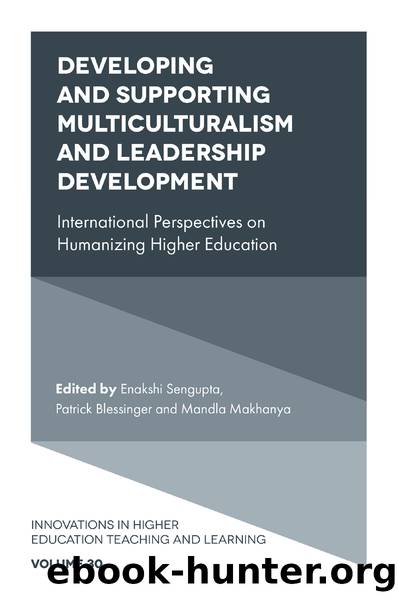Developing and Supporting Multiculturalism and Leadership Development by Sengupta Enakshi;Blessinger Patrick;Makhanya Mandla;

Author:Sengupta, Enakshi;Blessinger, Patrick;Makhanya, Mandla;
Language: eng
Format: epub
Publisher: Emerald Publishing Limited
Published: 2020-07-29T00:00:00+00:00
Fig. 1. BACEIS Model of Improving Thinking (Hartman & Sternberg, 1993).
The rest of the chapter demonstrates how principles of holistic, learner-centered instruction have been applied to faculty development in a diverse, urban, higher education setting. Included are strategies for planning, implementing and evaluating a variety of faculty development activities, both across the curriculum and subject specific.
FACULTY DEVELOPMENT
The faculty development described here provides a case study of how to utilize the referenced conceptual frameworks to model for faculty and help them learn to teach holistically and humanistically, using a learner-centered approach. The articulation between the frameworks and faculty development principles can be summarized as: (1) Holistic: Attend to the whole person including cognition, attitudes, motivation, culture and social relationships. (2) Adult learners: Elicit and build on prior knowledge and experience and apply what is learned to facultyâs own teaching and their studentsâ learning in classrooms and beyond. (3) Learner-centered: Enhance self-directed learning â engage faculty in self-evaluation and plans to improve performance, including using a variety of active and meaningful learning, strategies and giving learners choices. (4) Humanized environment: foster pro-social behavior, engage in cooperative and culturally responsive teaching and model respect for facultyâs beliefs values and experiences, demonstrating how to do it with their students.
Faculty development was across both the curriculum and subject specific. Activities included series of workshops for faculty college wide; a one-day annual seminar for faculty teaching new students; a year-long City University of New York-wide seminar for diverse faculty and administrators; workshops on assessment while the College was undergoing accreditation review, a summer seminar for engineering faculty; and a nine-year curriculum development collaboration with biology faculty, described elsewhere (Hartman, 2001b). Funding for faculty development was provided by federal and private foundation grants and the collegeâs budget.
Download
This site does not store any files on its server. We only index and link to content provided by other sites. Please contact the content providers to delete copyright contents if any and email us, we'll remove relevant links or contents immediately.
The Leadership Brain by David A. Sousa(452)
Think Like Socrates by Shanna Peeples(429)
Courageous Conversations About Race by Glenn E. Singleton(428)
Slaying Goliath by Diane Ravitch(391)
EndNote 1-2-3 Easy! by Abha Agrawal & Majid Rasouli(388)
More Board Game Education by Jeffrey P. Hinebaugh(335)
Leading in a Culture of Change by Michael Fullan(317)
What We Know About Grading by Thomas R. Guskey(311)
Crash Proof Your Kids by Timothy C. Smith(309)
Growing Weeders Into Leaders by Jeff McManus(307)
Academic Archives by Aaron D. Purcell(297)
Leverage Leadership 2.0 by Paul Bambrick-Santoyo & Doug Lemov(283)
One-Room Country Schools by Jerry Apps(260)
The Listening Leader by Safir Shane; Fullan Michael;(255)
Sound School Finance for Educational Excellence by Stephen Coffin & Bruce S. Cooper(254)
Transgender People and Education by Clare Bartholomaeus & Damien W. Riggs(245)
Urban School Leadership by Tom Payzant(240)
A Principal Manager's Guide to Leverage Leadership 2.0 by Paul Bambrick-Santoyo(237)
Should Robots Replace Teachers? by Neil Selwyn(229)
